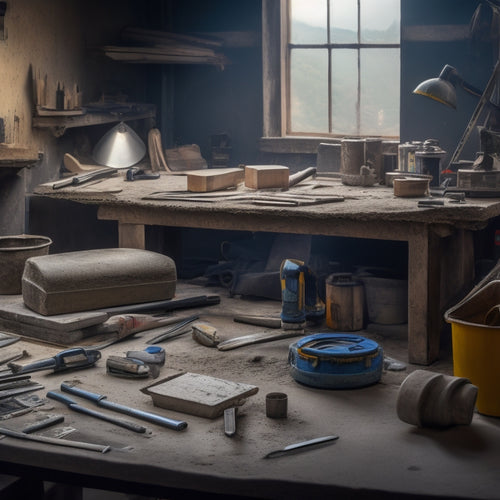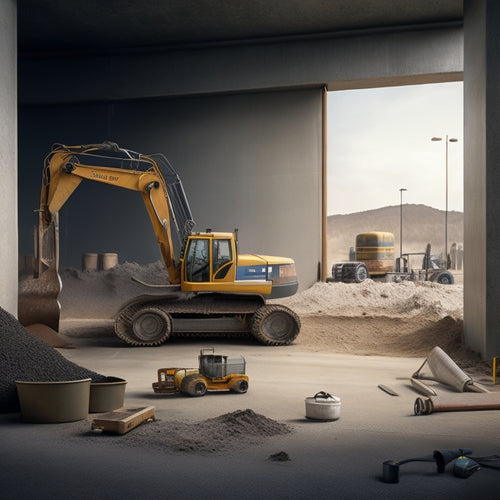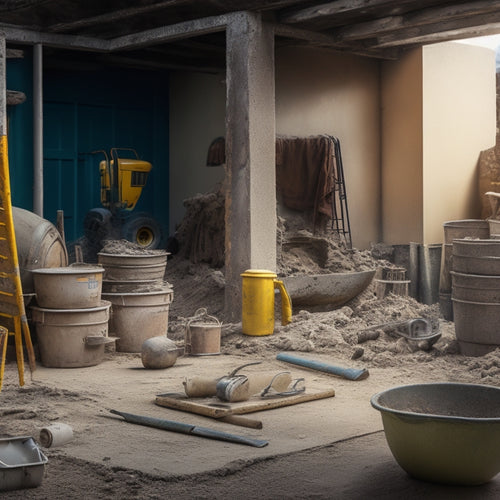
Top Tools for Demolishing Concrete Walls Fast
Share
When demolishing concrete walls, you'll need heavy-duty tools to get the job done fast. Reach for demolition hammers that deliver massive impact force, hydraulic breakers for tough walls, and electric jackhammers that speed up the process. For precision, pneumatic chisels are ideal, while concrete crushers can handle large blocks. Demolition saws help make clean cuts, and don't forget safety gear like hard hats and ear protection to keep you safe. With the right tools, you'll be able to tackle even the toughest concrete walls efficiently. Now, learn how to choose the best tools for your specific demolition project and get the results you need.
Key Takeaways
• Heavy-duty demolition hammers with high-torque motors and reinforced handles deliver massive impact force to break reinforced concrete walls efficiently.
• Hydraulic breakers provide intense hammer action for cracking thick concrete walls, especially those reinforced with steel rebar or fiber mesh.
• Electric jackhammers deliver rapid succession of high-impact blows for quick demolition, but require regular maintenance to prevent overheating.
• Pneumatic chisels with high-carbon steel, tungsten carbide, or diamond-coated bits offer precision demolition tasks with adjustable air pressure control.
• Demolition saws with diamond blades can make clean cuts in concrete, ideal for large areas or intricate cuts, with the right cutting techniques and safety precautions.
Heavy-Duty Demolition Hammers Needed
You'll need a heavy-duty demolition hammer capable of delivering massive impact force to break through thick, reinforced concrete walls. For heavy-duty applications, you can't settle for anything less. These hammers are designed to withstand the rigors of intense demolition techniques, providing the power and reliability you need to get the job done efficiently.
When working with reinforced concrete, you'll encounter rebar, wire mesh, and other obstacles that require extreme force to overcome. A heavy-duty demolition hammer is equipped with advanced features, such as high-torque motors and reinforced handles, to help you power through these challenges.
Look for a hammer with a high impact force rating, measured in joules or foot-pounds, to guarantee it can handle the toughest concrete walls.
Hydraulic Breakers for Tough Walls
When you're up against extremely thick concrete walls, you'll need a powerful tool that can deliver a strong, consistent blow.
That's where hydraulic breakers come in - these machines are designed to provide intense hammer action that can crack even the toughest walls.
Breaking Thick Concrete
Thick concrete walls put up a fierce resistance, but hydraulic breakers are the heavy-hitters that can demolish even the toughest barriers. These powerful tools can deliver the force you need to break through even the thickest concrete, especially when faced with a wall that's been reinforced with steel rebar or fiber mesh.
When approaching a concrete wall, it's essential to develop effective wall demolition strategies. This might involve identifying the wall's weakest points, such as areas where the concrete is cracked or deteriorated.
Once you've pinpointed these areas, you can use your hydraulic breaker to target them, applying controlled bursts of force to gradually dismantle the wall. By working methodically and strategically, you can break through even the toughest concrete walls and get the job done quickly and efficiently.
With the right tools and techniques, you'll be able to conquer even the most formidable concrete barriers.
Powerful Hammer Action
With hydraulic breakers, you're harnessing the power of intense hammer action to shatter even the toughest concrete walls. These powerful tools are designed to deliver rapid, repetitive hammer blows that can break through thick concrete with ease. When choosing a hydraulic breaker, consider the following key factors:
| Factor | Description | Impact on Performance |
|---|---|---|
| Chisel Size | Larger chisels provide more breaking power | Increased wall demolition speed |
| Blows Per Minute (BPM) | Higher BPM rates increase demolition speed | Faster wall demolition |
| Hydraulic Pressure | Higher pressures deliver more forceful hammer blows | Improved wall demolition efficiency |
To get the most out of your hydraulic breaker, don't forget to follow essential hammer maintenance tips, such as regular lubrication and chisel replacement. Additionally, consider implementing hammer performance enhancement strategies, like optimizing your breaker's hydraulic pressure and BPM rate. By doing so, you'll be able to tackle even the toughest concrete walls with confidence and speed.
Electric Jackhammers for Speed
You'll tackle concrete walls quickly and efficiently using electric jackhammers, which deliver a rapid succession of high-impact blows to demolish even the most stubborn structures. These powerful tools are designed to make short work of thick concrete, and with the right technique, you'll be able to bring down walls in no time.
To get the most out of your electric jackhammer, make sure to follow proper maintenance procedures, such as regular cleaning and lubrication of the hammer and bits. This will help prevent overheating and extend the life of your tool.
Additionally, always follow jackhammer safety precautions, including wearing protective gear like gloves, safety glasses, and a dust mask. Keep a firm grip on the handle and maintain good footing to avoid losing control of the hammer.
With an electric jackhammer and the right techniques, you'll be able to demolish concrete walls quickly and safely. By following these tips, you'll be well on your way to mastering the art of concrete demolition.
Pneumatic Chisels for Precision
When you're working with pneumatic chisels for precision demolition, you'll need to carefully select the right chisel bits for the job, as they're designed for specific tasks like breaking up concrete or removing tile.
You'll also need to master air pressure control to avoid damaging surrounding structures or injuring yourself.
Chisel Bit Selection
Selecting the right chisel bit for your pneumatic chisel is vital, as it directly impacts the efficiency and precision of your concrete demolition project.
You'll want to choose a bit that's designed for the specific type of concrete you're working with, as well as the level of demolition required. There are three primary chisel material types to evaluate: high-carbon steel, tungsten carbide, and diamond-coated.
High-carbon steel bits are ideal for light to moderate demolition, while tungsten carbide bits offer increased durability and are better suited for heavier demolition. Diamond-coated bits, on the other hand, provide the highest level of precision and are perfect for detailed work.
To get the most out of your chisel bit, it's important to maintain it properly. Regularly inspect your bit for signs of wear, and replace it when necessary.
Clean your bit after each use to prevent concrete residue buildup, and store it in a dry place to prevent rust.
Air Pressure Control
With precise air pressure control, your pneumatic chisel becomes a finely tuned instrument, capable of delivering exactly the right amount of force to demolish concrete walls with surgical precision.
You'll be able to tackle even the toughest demolition jobs with confidence, knowing that your tool is functioning at peak efficiency.
To achieve this level of precision, it's crucial to understand the importance of pressure regulation. Here are a few key considerations to keep in mind:
-
Adjustable pressure regulators allow you to fine-tune your air pressure to suit the specific demands of your job.
-
Gauges and meters provide real-time feedback on your air pressure, making sure you're working within the ideal range.
-
Pressure relief valves safeguard against excessive pressure buildup, protecting your tool and preventing accidents.
- Air hoses and fittings must be carefully selected to minimize pressure drops and guarantee consistent airflow.
Concrete Crushers for Large Blocks
You'll need a concrete crusher capable of producing massive amounts of force to break down large concrete blocks into manageable pieces. When it comes to concrete recycling, a crusher is an essential tool for reducing large blocks into smaller fragments that can be easily transported and reused.
Here are some key considerations when selecting a concrete crusher for large blocks:
| Crusher Type | Force Capacity | Block Size Handling |
|---|---|---|
| Hydraulic Crusher | 100-200 tons | Up to 5 ft x 5 ft |
| Pneumatic Crusher | 50-100 tons | Up to 3 ft x 3 ft |
| Electric Crusher | 20-50 tons | Up to 2 ft x 2 ft |
When transporting crushed concrete blocks, consider the weight and size of the blocks to guarantee safe and efficient block transportation. A concrete crusher with a high force capacity can help reduce the block size, making it easier to transport and recycle. By choosing the right crusher for your project, you can optimize your concrete recycling process and save time and resources.
Demolition Saws for Clean Cuts
Two demolition saws are necessary for making clean cuts in concrete walls: a walk-behind saw for larger areas and a handheld saw for more precise, intricate cuts.
You'll want to choose the right blade type for your saw, as it can greatly impact the quality of your cut. Diamond blades are ideal for concrete, as they provide a smooth, consistent cut.
When it comes to cutting techniques, you'll want to use a slow, steady motion to maintain control and prevent kickback.
Here are some additional tips to keep in mind:
-
Always keep your saw blades sharp to prevent overheating and reduce the risk of kickback.
-
Use a push technique for walk-behind saws and a pull technique for handheld saws.
-
Apply gentle to moderate pressure, depending on the saw and the concrete.
- Keep your work area clean and clear of debris to guarantee a smooth, safe cutting process.
Safety Gear for Protection First
Protect yourself from the dangers of concrete demolition by wearing essential safety gear, including hard hats, safety glasses, ear protection, and dust masks.
You're about to tackle a physically demanding task that involves heavy machinery, flying debris, and toxic dust. Don't take any chances - prioritize your safety above all else. Familiarize yourself with local safety regulations to guarantee you're meeting the minimum requirements.
Invest in high-quality protective equipment that can withstand the rigors of concrete demolition. A hard hat will protect your head from falling objects, while safety glasses will shield your eyes from flying particles.
Ear protection will prevent permanent hearing damage, and dust masks will filter out hazardous airborne particles. Don't skimp on safety gear - it's a small investment compared to the potential cost of an injury.
Frequently Asked Questions
What Is the Average Cost of Renting a Demolition Tool?
When you're planning a demolition project, you're probably wondering what the average cost of renting a demolition tool is.
Well, the answer depends on the type of tool and rental duration. On average, you can expect to pay between $100 to $500 per day for a hydraulic breaker or demo saw.
For a more precise estimate, research local rental companies and compare their demolition tool pricing to find the best deal.
This rental cost comparison will help you budget efficiently and get the job done quickly.
Can I Use a Demolition Hammer for Indoor Projects?
You're about to release a wrecking ball on that concrete wall, but first, let's talk demolition hammers for indoor projects.
Can you use one? Absolutely! However, remember that demolition safety is paramount, especially indoors.
Be prepared for the intense vibrations and consider wearing protective gear.
Also, be mindful of indoor noise levels, as demolition hammers can be loud.
With proper precautions, you'll be smashing through concrete like a pro in no time!
Are Hydraulic Breakers Suitable for Underwater Demolition?
When tackling underwater demolition, you'll face unique challenges that demand specialized tools.
Hydraulic breakers are suitable for this task, as they offer superior hydraulic efficiency in water.
Their sealed systems and specially designed components minimize water ingress, ensuring consistent performance despite the underwater environment.
You'll appreciate the increased power and precision they provide, making quick work of even the toughest underwater demolition projects.
How Often Should I Lubricate Pneumatic Chisels?
Are you tired of dealing with stuck or seized pneumatic chisels? You're not alone. Proper pneumatic chisel maintenance is key to avoiding these issues.
When it comes to ideal lubrication frequency, you should aim to lubricate your chisel every 1-2 hours of use, depending on the environment and workload.
Don't wait until it's too late - regular lubrication will keep your chisel running smoothly and efficiently.
Can I Use a Demolition Saw to Cut Through Rebar?
You're wondering if you can use a demolition saw to cut through rebar. The answer is yes, but you'll need to choose the right blade.
Look for a diamond-coated or carbide-tipped blade specifically designed for cutting rebar. These blades are built to handle the tough, embedded metal.
When cutting, apply gentle to moderate pressure, depending on the saw's power and the rebar's thickness. Keep the saw steady and move slowly to avoid binding or kickback.
Conclusion
You've made it to the final swing - literally! Demolishing concrete walls quickly requires the right tools for the job.
Remember, a demolition hammer is like a conductor leading an orchestra - it sets the pace for the entire operation.
In fact, a study by the Construction Industry Institute found that using the right tools can reduce demolition time by up to 40%.
With the top tools in your arsenal, you'll be knocking down walls in no time!
Related Posts
-

3 Best Hand Tools for DIY Concrete Construction
When tackling a DIY concrete construction project, you'll need three essential hand tools to achieve a professional-l...
-

Why You Need Affordable Concrete Wall Construction Tools
You need affordable concrete wall construction tools to guarantee a profitable project, as the cost of equipment can ...
-

What Tools Are Needed for Concrete Wall Foundations
You'll need a thorough array of tools and equipment to construct a concrete wall foundation that meets structural int...


